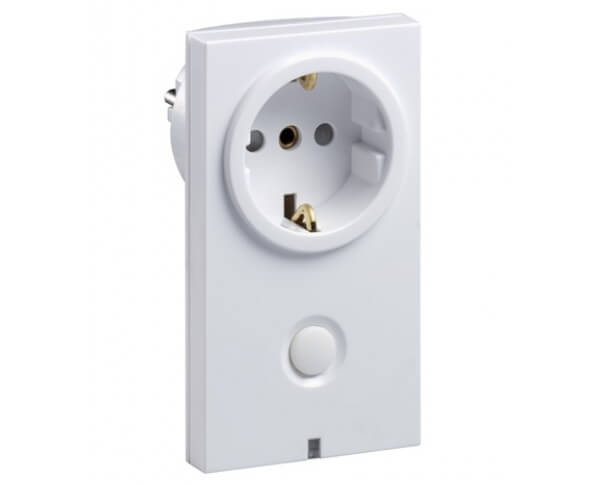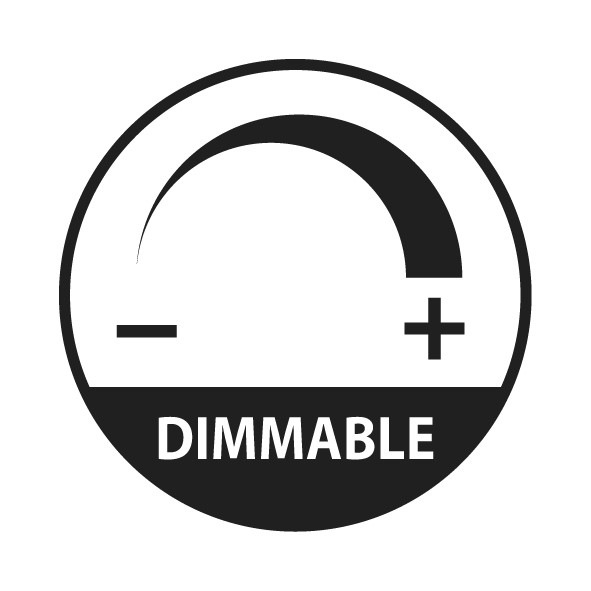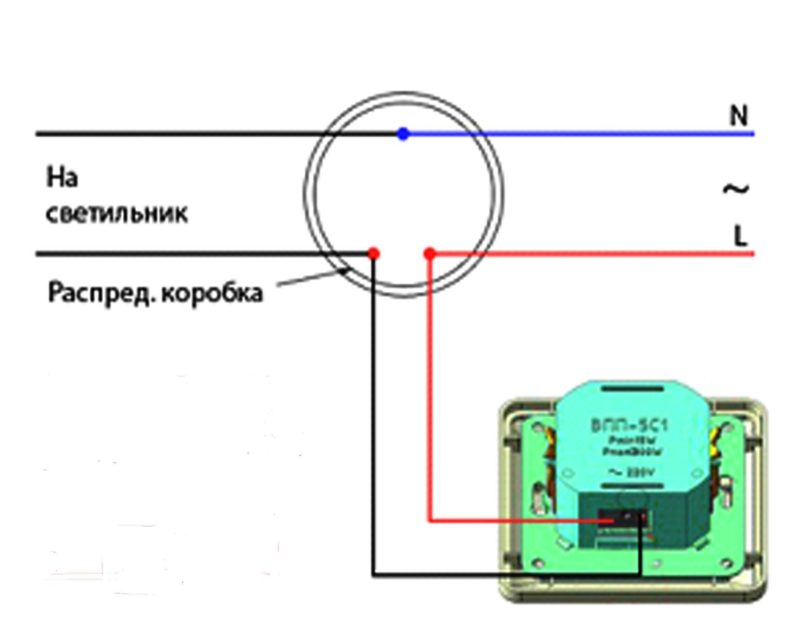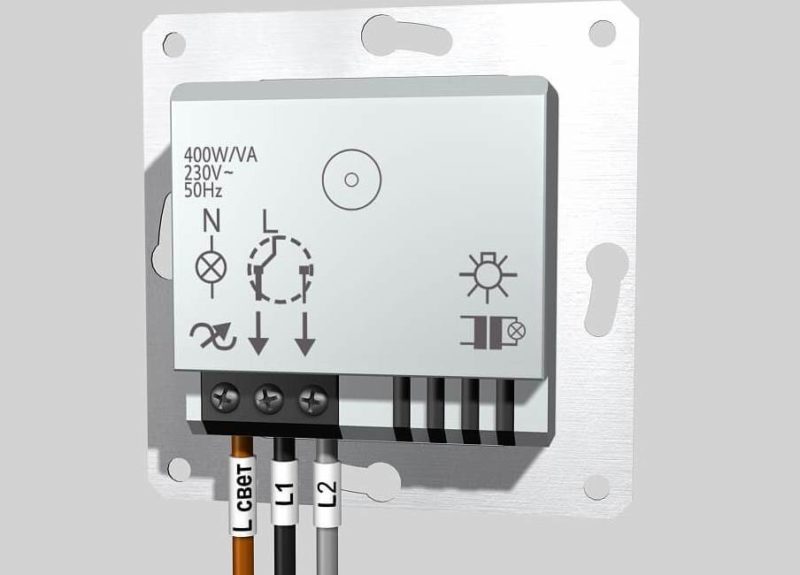Wiring diagrams for dimmers with and instead of a switch
The question of regulating the brightness of the lamps probably arose immediately after the invention of electrical lighting devices. The easiest and most obvious way is to turn on in series with the lamp of resistors - was soon recognized as a dead end. With this method, part of the power is uselessly dissipated on the resistor, and the main goal of regulation - saving electricity - is not achieved. Ways were found to reduce the brightness of the glow by distributing power over time using electronic switches. Based on this principle, household appliances were developed and used, called dimmers (to dim, to dim).
A simple dimmer
In the most trivial case, the connection diagram of the dimmer is simple: in the gap of the phase wire of the chandelier or other lighting fixtures, like a switch. It performs the functions of a switch - in addition to the service of dimming. Simple dimmers come in the form of household switches - for easy replacement and installation. One device is replaced by another. By turning the dimmer button the brightness is adjusted, in the minimum position the control can be turned off. More advanced models have a rotary pushbutton design. Adjustment is done in the same way, and switching off is done by pressing. The advantage of this design is that it "remembers" the level set. The rotary knob remains in the same place, and the next switch-on occurs at the same brightness level. Even more expensive models have touch control, audio control, remote control, etc.
Pass-through switches and dimmers
There is a scheme for controlling lighting with feed-through switches. They form a system by which lighting can be switched on and off independently from two points spaced apart in space. For example, it is convenient to turn lights on when entering a long corridor and turn them off when exiting.

These switches have a group of contacts for switching instead of a single contact for closing and opening. With the advent of dimmers came the idea of installing a dimmer in this circuit. For example, to adjust the brightness level of the lamp depending on the environment.

A dimmer can be installed on one side. At the same time, it can act as an additional light switch - if necessary to completely break the circuit. The best idea seems to be the use of a dimmer with a flip-flop group of contacts instead of a single switch - switching takes place by pressing a key (rotary-push type).

It is unlikely to be possible to install two-way dimmers on both sides for two reasons:
- The controller design does not allow access to the changeover contact;
- the first dimmer to the source will "slice" the sine wave so that the effect of the second on the brightness will be unpredictable.
Here there is a vast field for lovers of experiments and modifications. The main thing is not to forget about safety.
Modular dimmer

These dimmers are used for lighting entrances and similar pass-through premises. Their peculiarity is that the controller unit and the control button are separated in space. The main module is in most cases, in the switchboard. The control button is installed in any convenient place - at the entrance door, on the control panel, etc. The brightness control is located on the body of the main module, and the required level is set during adjustment.

Except for the most budget models, modular dimmer can have additional service functions:
- memory (the preset brightness level is retained the next time you turn it on);
- smooth rise and fall of the light;
- possibility of setting the time of rising and falling of the highest light level;
- other services.
The most advanced models can be assembled into master-slave systems. In this version, the light level is set on the master device, and the others follow it, controlled by an analog signal bus.
Dimming table lamp
Table lamp dimming control is a feature of using table lamptable lamp, floor lamp and other movable lighting fixtures is that they can be plugged into any of the available outlets. Equipping each outlet with a separate dimmer is not the best solution. Putting a dimmer inside the fixture is not always possible, either. It is much more convenient to use specially designed dimmers, designed for such purposes.

Dimmer-adapter is inserted into a household socket, forming the same connector with a knob to adjust the light level (even more convenient devices with touch control). And a floor lamp or table lamp is plugged into it. If necessary, the dimmer can be moved to another place. Also, there are network extension cords with a built-in dimmer. The customer can choose the convenient option himself.
Self-installation of a dimmer switch
Actions to replace the switch with a dimmer start with the selection of a dimmer. The design of the device - rotary, rotary-push, sensor, etc. in this case does not matter. The first thing you should start with the choice - the type of lamps to be controlled. You can find it in the instruction manual of the device or look for a letter marking on the housing.
| Alphabetic marking | Symbolic marking | Load type | Controlled lamps |
| R | Ohmic | incandescent | |
| C | Capacitive | With electronic ballast | |
| L | Inductive | Low voltage halogen lamps with winding transformer |
Many dimmers allow mixed loads (RL, RC, etc.). If you intend to dim fluorescent lamps, make sure that they are labeled "dimmable" (dimmed) on their packaging. Otherwise the system will not work.
Important! Before trying to connect an LED lamp, you must also make sure that it has the label "dimmed". If there is no such a label, it means that the lamp has a driver in the form of a current stabilizer and an attempt to regulate the brightness by controlling the average current from outside will be ineffective. This does not apply to LED strips - their current through the LED is limited by ordinary resistors and the glow is well controlled by an external average voltage. Therefore "non-dimming" LED strips do not exist, despite the tricks of marketers.
The second important parameter is the highest power. It should overlap the total power of the switched luminaires with a reserve. According to this characteristic it is not necessary to choose a dimmer "on the edge". The rest - performance, design, etc. - to the taste and wallet of the buyer.

What you need to prepare
Installation of the dimmer begins with the selection of tools. At a minimum you can get by with two screwdrivers:
- A large one for tightening (loosening) the blades of the dimmer (switch);
- A smaller one for clamping and loosening the terminals fixing the wires.
Will not be superfluous in this work:
- indicator screwdriver;
- multimeter.
You may need other small tools (a utility knife, etc.).
Disassembling the original switch
Installing any dimmer in place of a switch is advisable to start with a check of the installation - it is necessary to make sure that the phase wire is disconnected. In 99% of cases it will turn out that the installation was performed correctly. But it is necessary to exclude all surprises. If a careless craftsman has put a switch in the zero gap, it will not affect the performance of the system without a regulator (as opposed to safety). The dimmer, on the other hand, needs correct phasing. You can check this with a voltage indicator (indicator screwdriver). If this is OK, you can proceed to the next step. If not, there is a lot of work to be done. And it is better to think whether dimming is worth it (safety is worth it, for sure).
The second, and very important step is to turn off the power to the lighting system. This is usually done at the switchboard.
Important! After disconnecting the switching element, you must always check that there is no voltage directly at the workplace. Do not trust the diagrams in the switchboard and the inscriptions on the circuit breaker.
After making sure that the switch is not energized, you must remove the switch cover, loosen the terminals to which the wires are connected, and loosen the lugs with which the switch is spread in the box. After that, you must carefully remove the switch unit and pull the wires out of the terminals. This should be done carefully so as not to break off the exposed areas.
The short video instruction.
Dimmer mounting
The dimmer has the same dimensions and mounting dimensions. Therefore, installation is carried out in reverse order:
- the dimmer is installed in its seat;
- Wires are connected to their terminals;
- the regulator is fixed in the box by loosening the petals;
- the screws of the terminals for fixing the wires are tightened;
- the regulator cover is closed.
This completes the connection of the dimmer. You can apply voltage to the lighting system and try the dimmer in operation.

